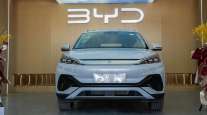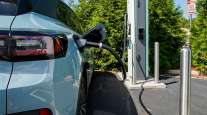Senior Reporter
Electrification Finds Its Ground Zero in California

LONG BEACH, Calif. — Expanding options for battery-electric technology and hybrid-electric and natural-gas engines are converging alongside efforts to protect forthcoming clear-air regulations, and longtime industry players must be ready to react to this evolving landscape, panelists said here at the Advanced Clean Transportation Expo, held April 30-May 3.
“The push for electrification and alternative fuels is the most significant change we are seeing in our lifetime impacting the commercial vehicle industry and it is requiring some of the greatest investment we will ever see in the history of the industry,” Meritor Inc. CEO Jay Craig said during his keynote speech.
Meritor, whose roots go back to 1913, “could be irrelevant in a decade if we don’t invest in advanced technology,” he added. “The technology will come to us from the other side of the globe if we don’t embrace it.”
Meritor is a global supplier of drive axles and braking components.
Electrification is unmistakably on the rise amid recent corporate announcements of new electrified trucks — and customers who have placed orders for them.
UPS Inc., for one, has preordered 125 of the Tesla Semi all-electric trucks being developed by the company best known for its electric cars.
That move was perhaps unsurprising for UPS, which has long been an advocate of developing a broad perspective on alternative fuels given the company’s range of operating environments, said Tamara Barker, the company’s chief sustainability officer. UPS has a “rolling laboratory” of nearly 9,100 vehicles running on a variety of alternative fuels, she said, and has set a goal of reducing absolute emissions 12% across its global ground operation by 2025 even as its business continues to “grow at a rapid pace.” UPS handles 6% of the U.S. GDP and 2% of global GDP every day, according to the company.
UPS ranks No. 1 on the Transport Topics list of the largest for-hire carriers in North America.

Tesla Semi by Alexis Georgeson/Tesla Motors
One truck maker underscored advances in alternative-fueled truck design as a means of attracting more drivers, operating under safer conditions.
A key goal with advanced clean technologies is to “develop enough [new] vehicles that we can find drivers for,” said Steve Gilligan, vice president of product and vocational marketing at International Truck and Engine Corp., a unit of Navistar Inc.
He noted that the booming new heavy-duty truck market underway now has not brought in a lot of new drivers.
Fleets must also consider total cost of ownership for alternative-fuel vehicles, as well as government subsidies and penalties for both alternative- and diesel-powered trucks, said Julie Furber, Cummins executive director for electrification.
“How fast or slow these things change is what will determine the rates of adoption,” she said, noting that the trucking industry is entering a world where there is no one-size-fits-all.
“We are reaching a place with a variety of choices to help the customer,” she said. Right now, longhaul driving of 500 miles a day belongs to diesel powertrains, she said. “Cummins continues to work to make diesel engines cleaner” than they ever have been,” she said.
Regional hauls can benefit most from natural gas engines if those trucks have access to the needed infrastructure, she said. Or a utility truck could turn to a hybrid-electric application to provide the “utmost flexibility.”
Questions about the use of various powertrains hung over the proceedings, as California and 17 other states on May 1 sued the U.S. Environmental Protection Agency to protect automobile greenhouse-gas standards adopted in 2012 but which do not take effect until 2022. The suit is a reaction to EPA’s claim in April that clean car standards for model years 2022-2025 should be scrapped.
Beginning in 2010, the EPA, National Highway Traffic Safety Administration and California Air Resources Board established a single national program of greenhouse gas emissions standards for model year 2012-2025 vehicles. The program allows automakers to design and manufacture to a single target, according to a statement for California Gov. Jerry Brown’s office.
Meantime, California regulations covering commercial trucks continue, said Analisa Bevan, assistant division chief of Emissions Compliance, Automotive Regulations & Science Division at CARB.
One speaker dubbed California “ground zero” for zero-emissions technologies, as areas around Los Angeles have some of the nation’s poorest air quality.
The state faces approaching stringent federal deadlines to address the situation, but California is taking “a sector-by-sector approach of looking at how we can transform the transportation sector to zero emissions,” Bevan said.




